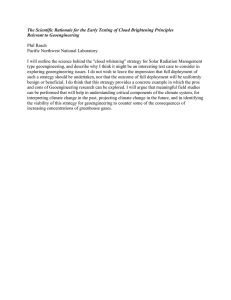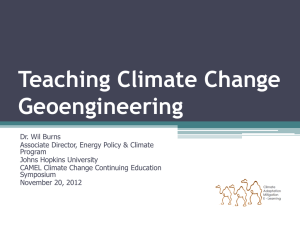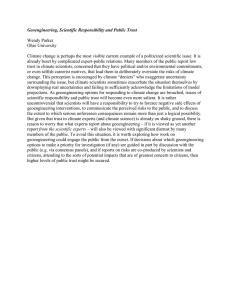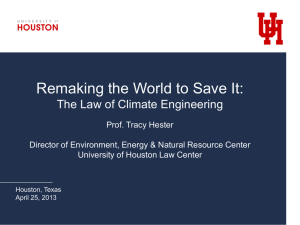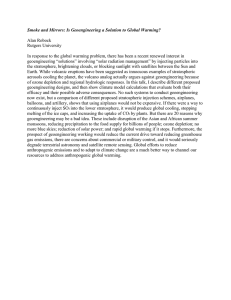A proposal for limited implementation of a sunshade global biogeochemical cycles
advertisement
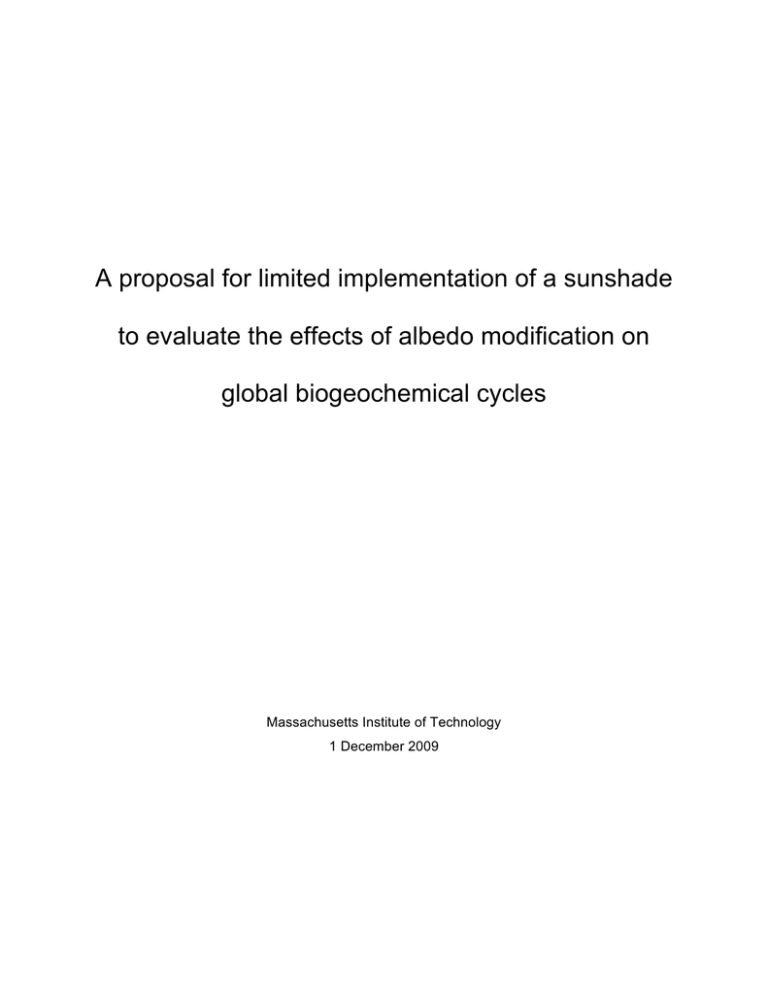
A proposal for limited implementation of a sunshade to evaluate the effects of albedo modification on global biogeochemical cycles Massachusetts Institute of Technology 1 December 2009 Executive summary Climate change caused by anthropogenic emissions of carbon dioxide and other greenhouse gases threatens to negatively impact human lifestyles across the globe through droughts, floods, and rising sea levels. In spite of these concerns, the amount of carbon dioxide emitted annually has continued to increase in the past decade, from 6.4 Gt of carbon every year in the 1990’s to 7.2 Gt in the following decade (Bala, 2009). In addition, a recent study suggests that even if emissions were completely cut, it is too late to prevent temperature and sea level rises. In view of these predictions, more direct methods of maintaining the earth’s present climate, such as geoengineering, are a possible solution. Geoengineering is any attempt to purposefully modify the environment on a large scale. However, it is likely that in modifying the earth’s systems to solve one problem, geoengineering schemes would create a host of negative unintended consequences. These consequences, which might include pollution, precipitation changes, or declining productivity, have the potential to be more serious than the climate change caused by global warming. Therefore, it is important to thoroughly investigate the side effects of any scheme before implementation. In this paper, I propose to study the unintended effects of a geoengineering pitch authored by Roger Angel of the University of Arizona by partially implementing his plan. Angel (2006) proposes to send small disks into space between the earth and sun to deflect a fraction of the incoming solar radiation and thus cool the earth. To study the effects of this sunshade, I propose to install about 10% of the total number of disks. This limited implementation should affect Earth’s climate no more than a volcanic eruption would; at that scale, scientists would be able to measure small changes in precipitation and net primary productivity and extrapolate their findings to predict the effects of a full-scale implementation. Even though geoengineering is an extreme option, it may become one day become the best way to negate the harmful climate changes caused by global warming. Experiments such 2 as the one I propose must take place before implementing a geoengineering plan, and thus the time to conduct these experiments is now, before the day of need. 3 Introduction The causes and consequences of global climate change The elevated levels of CO2 in the atmosphere threaten to dramatically alter global climate. Ordinarily, CO2 and other greenhouse gases (GHGs) keep the earth’s surface at habitable temperatures. GHGs allow short-wave radiation from the sun to reach the earth’s surface, but they readily absorb the long-wave radiation released from Earth’s sun-warmed surface. By retaining this thermal energy, GHGs trap heat on the earth’s surface, historically keeping enough to raise the average global temperature by 20ºC (Smith & Smith, 2001). In recent decades, the burning of fossil fuels, concrete production, and other human activities have released unprecedented amounts of CO2 into the atmosphere (Bala, 2009). Before industrialization, CO2 atmospheric concentrations were 280 ppm. Today, the gas comprises 381 ppm and increases by 2-3 ppm annually (Canadell et al., 2007). Already, the heat trapped by GHGs has already caused an average global temperature increase of 0.8ºC, and climate models predict that is will rise another 1.8-4ºC within the century (Bala, 2009). The oceans in particular will be directly affected by global temperature increases. When the ocean temperature rises, the water will expand, possibly raising sea levels by 1-2 m. Melting ice sheets could raise levels another 1-2 m. As some of the extra CO2 dissolves in the oceans, it will form carbonic acid, bicarbonate, and carbonate, increasing the ocean acidity. Ocean acidification negatively impacts marine life for example by preventing calcification in coral reefs and interfering with the sense of smell in certain fish (Anthony et al., 2008; Munday et al., 2009). Already, the temperature, level, and acidity of the ocean have risen, while the on-land reserves of water in mountain glaciers and snow cover have declined (Bala, 2009). If temperatures continue to increase, the scale of these consequences grows. The change in climate will destroy homes and livelihoods (Solomon et al., 2009). The rising ocean will submerge low coastal plains and small islands. Additionally, a warmer 4 atmosphere will contain more water vapor, which will create sweeping, unpredictable precipitation changes (Soloman et al., 2009). Droughts and floods will be more frequent, and tropical cyclones more intense (Bala, 2009). Rainfall will decrease by 10-20% in parts of every continent, which will impoverish water resources, disrupt agriculture, increase desertification, and change ecosystems. This level of water shortage is much greater than the one that triggered the Dust Bowl of the 1930’s, which was created by a 10% decline in rainfall during little more than a decade. In global warming scenarios, the drought will be both larger and longer (Soloman et al., 2009). To preserve the present climate, the world must cut emissions. Yet, despite any political measures, industries are releasing more GHGs into the atmosphere than ever before. In the 1990’s, human activities released 6.4 Gt of carbon every year, and from 2001-2004, the rate increased to 7.2 Gt C/year (Bala, 2009). At this point, even if CO2 emissions completely cease, 40% of the human-added carbon will permanently remain in the atmosphere (Solomon et al., 2009). As Figure 1 shows, after emissions stop, the global temperature will remain elevated, influenced by the warmer ocean. The ocean temperature will slowly increase as the water mixes with the warmer atmosphere. 5 1000 800 5 Zero emission after peaks Peak at 1200 Surface warming (k) Emission growth 850 600 750 650 400 550 1800 2000 2200 450 2400 Year 2600 2800 Global average warming 4 3 2 1 0 1800 3000 2000 2200 2400 2600 Year 2800 3000 2600 2800 3000 2 2%/year growth to peak Preindustrial Thermal expansion (m) CO2(ppmv) 1200 Thermal expansion of ocean 1.5 1 0.5 0 1800 2000 2200 2400 Year Image by MIT OpenCourseWare. Figure 1: CO2 levels, increased surface temperature, and the rise in sea levels over the next thousand years. The change in sea level accounts only for thermal expansion, not for ice melt. The different lines represent different levels of CO2 when emissions stopped, including 450, 550, 650, 750, 850, and 1200 ppm. In this time scale, the temperature and sea level increases appear permanent. (Soloman, Plattner, et al., 2009) The persistence of CO2 levels suggests that no cut in emissions will be enough to completely alleviate climate change. Clearly, there is a need for more direct and dramatic action to counter the effects of global warming. 6 Geoengineering: a more dramatic action Any attempt to negate global warming by deliberately modifying the earth’s temperature would be classified as geoengineering. The term designates any modification of the environment that is both intended and extensive (Keith, 2000). Although today the term overwhelmingly refers to proposals to combat anthropogenic warming, the aims can be more diverse. For decades, geoengineering was not taken seriously. Then in 2006, Paul Crutzen, a Nobel Laureate in chemistry, published a paper advocating injecting sulfur into the stratosphere. He was frustrated by failed attempts to curb emissions, and he proposed geoengineering as the best option. Well respected for having discovered ozone depletion, Crutzen gave more legitimacy to the entire geoengineering field (Schneider, 2008). Current geoengineering schemes can be divided into two categories: carbon sequestration and solar shading (Bala, 2009). Figure 2 gives a pictorial summary of many of these proposals. 7 Marine cloud seeding Reflectors in orbit Aerosols in stratosphere Reflecting white roof Planting new trees Iron fertilization Reflecting materials on oceans Direct injection of CO2 Geologic sequestration of CO2 Image by MIT OpenCourseWare. Figure 2: An illustration of many geoengineering proposals. Carbon sequestration removes carbon from the atmosphere and stores it elsewhere. Iron fertilization, planting new trees, and geologic sequestration are examples of carbon sequestration. Albedo modification schemes increase the amount of solar radiation reflected into space, which here is the purpose of the various reflectors and cloud seeding. (Bala, 2009) In carbon sequestration, carbon is removed from the atmosphere and stored in organisms, deep in the ocean, in minerals, or in geological deposits of oil (Bala, 2009). One way to sequester carbon is iron fertilization, or adding iron to the oceans (Keith, 2000). In much of the ocean, iron is the limiting nutrient, so adding iron will cause prodigious phytoplankton growth. The elemental ratio of carbon to iron in ocean debris is 10,000:1, so for every mole of iron added to the ocean, biological organisms will consume 10,000 moles of carbon. When these organisms die, they will sink and sequester that carbon deep in the ocean. Like all the schemes, iron fertilization has its drawbacks. As the phytoplankton sequester carbon, they also take in large amounts of nitrogen and phosphorous and depleting ocean fertility. Furthermore, when the phytoplankton die, detritivores consume them, in the process depleting oceanic 8 dissolved oxygen levels. Finally, iron fertilization sequesters carbon by disturbing marine ecosystems, which could hurt every level of marine life (Strong et al., 2009). Another proposal to permanently sequester carbon is to bind it to magnesium and calcium silicates. Because carbon binds in a 1:1 ratio, however, proposals to use these substances to isolate carbon are prohibitively expensive (Keith, 2000). The second major way to actively lower global temperature is to increase the earth’s albedo, or reflectivity. The idea is to reflect some fraction of solar radiation away from earth, thus counteracting the extra heat trapped by GHGs. There are numerous proposed mechanisms, as Bala (2009) explains. One way is to put sulfur, dust, or highly reflective particles into the stratosphere. Another is to coat portions of the ocean with reflective particles, and another is to increase cloud cover by releasing H2SO4 over the ocean to act as cloud condensation nuclei. A final way is to put either one large or many small sunshades into space to directly block some sunlight from reaching earth Albedo modification proposals have several drawbacks. Many cause pollution by adding foreign particles to the atmosphere and the oceans, and they do nothing to address ocean acidification (Bala, 2009). In addition, even though they maintain a global temperature, they still change the global hydrological cycle and likely decrease global precipitation (Lunt et al., 2008). The albedo modification schemes are quite intricate, and it is not immediately apparent whether their benefits would outweigh their side effects. Therefore, it is worth investigating one of them in greater detail. Albedo modification through a cloud of small spacecraft In his paper, Angel (2006) proposes to send small spacecraft, or flyers, to form a cloud in space that will deflect solar radiation. The cloud will decrease the incoming solar flux by 1.8%, enough to negate the temperature increase caused by doubled CO2 concentrations. Rockets will 9 take the pre-assembled flyers to the L1 Lagrange point, a place between the earth and sun where the gravity forces from each body exactly cancel (Seifritz, 1989). The L1 Lagrange point is a saddle point, meaning that the flyers will drift away without active stabilization. Angel (2006) describes two strategies to keep the flyers in place. First, scientists will minimize the radiation pressure on the flyers. Radiation pressure is the pressure that electromagnetic radiation exerts on any object it encounters. This pressure is twice as strong on objects that reflect the radiation compared to those that absorb it. To minimize radiation pressure, the flyers will deflect the solar radiation’s path by a few degrees instead of reflecting it back towards the sun. The spacecraft are far enough away that even this small change in path will cause the radiation to shoot wide of the earth, continuing farther into space. To further secure the sunshade, scientists will place on every flyer a radio receiver and sensors to detect position, velocity, and sunlight. The receiver will communicate with larger spacecraft that will be interspersed throughout the cloud, which will in turn relay information to Earth. Based on instructions from Earth, these spacecraft will direct the flyers how to move. The flyers will harness radiation pressure to propel movement, using mirrors to channel the distributed force and create the desired velocity. Each flyer will be made of an extremely light, transparent film pierced with many holes. The light that passes through the film will be delayed by half a period relative to the light that passes through the holes, so they will destructively interfere with each other. The film will have varying levels of thickness, each width retarding a different wavelength of light, and thus creating maximum interference. Figure 3 illustrates the flyers’ material. 10 Image removed due to copyright restrictions. Figure 3: A close-up of the flyer material. (a) The flyers are made of a thin film pierced with holes. (b) The different levels of thickness impede light of different wavelengths, thus creating interference with a wide spectrum of the light that passes through the holes. (Angel, 2006) As with any wave, when light passes through a slit, it ripples out the other side in every direction, as Figure 4 illustrates. The spacing of the holes in the flyer will determine how the light that passes through the different holes will interfere, and therefore the hole spacing will determine the overall angle of deflection of the light through the sun shade. 4λ 3λ Light with wavelength 2λ λ 1λ 1λ 2λ 3λ 4λ Image by MIT OpenCourseWare. Figure 4: Light moving through a slit. When light passes through a slit, it ripples outward in semi-circles on the other side. The numbers along the line mark the distance away from the slit. The dashed lines mark places of interference between the ripples. The distance between the two slits determines the angle of these lines of interference, and thus the angle of deflection of the light that will pass through the sunshade disks. (Bawendi, 2008) 11 In total, the cloud will be 100,000 km long, about 15 times the size of the radius of the earth. The length is needed to continuously shade the earth throughout all the irregularities of the planet’s orbit, which are caused by the pull of the moon. Angel (2006) estimates that it will cost several trillion dollars over 25 years to implement the flyers, or about 0.5% of the world’s GDP over that time. This cost is significantly lower than similar proposals in the 1980’s, which would have cost 6% of the world’s GDP (Bala, 2009). The strength of the plan is that it will take place in space, where the variables are few and the physics is well understood. Angel (2006) predicts that the flyers will affect only the solar constant. They will not pollute the earth, and if they are ever unwanted, scientists can direct them away from the L1 Lagrange point. The scheme is robust precisely because it minimizes chances for error. The greatest technological hurdle is to install and maintain the flyers, but if successfully positioned, they will cool the earth. Whether they will also produce unintended and undesirable changes on the earth’s surface, however, is a question that warrants further study. 12 Experiment proposal Unintended effects of a sunshade in space on global cycles The aim of a sunshade such as the one proposed by Angel (2006) is to preserve current lifestyles by maintaining the earth’s current temperature. It would be naïve, however, to assume that humans could adjust two fundamental engines of earth processes, the thermal heat retention and the solar constant, without altering a host of other global biogeochemical cycles, including temperature distribution, net primary productivity, and the hydrological cycle. The sections below will, in layers of building complexity, describe relevant ecological processes. They will then relay the effects that computer modeling predicts a sunshade would have on these processes in a world with double the current amount of CO2. Layer 1: Global temperature A sunshade endeavors to reduce incoming solar radiation in order to counteract the excess long wave radiation trapped by greenhouse gases, as Figure 5 illustrates. There are marked differences, however, in the way solar radiation and long wave radiation heat the earth. Solar radiation reaches the earth only during the day, varies in intensity with latitude, and changes in distribution with the seasons. Greenhouse gases such as CO2, by contrast, are more evenly spread over the earth’s surface, continually present, and vary less directly with seasons. As a consequence, we would expect the amplitude of the daily, seasonal, and latitudinal temperature variations to decrease in a world increasingly heated by CO2 (Govindasamy & Caldeira, 2000). 13 Figure 5: The balance between incoming and outgoing energy. Greenhouse gases reduce the earth-emitted energy, increasing the earth’s temperature. To negate this effect, a sunshade would deflect some of the solar incident energy, increasing the solar reflected energy. (NOAA) The simulation by Govindasamy and Caldeira (2000) shows a surprisingly small decrease in these cycle amplitudes. In their results, the amplitude of the diurnal cycle decreased by only 0.1ºC, and only 15% of the earth experienced significant temperature changes relative to today’s average. The effects were greatest near the equator, where the sun shines most directly and its decrease would be most felt. Seasonal cycles actually heightened relative to a CO2-rich earth because increased sea ice insulated the winter atmosphere from the warming effects of the ocean. Temperature changes are undesirable, but the next unintended effect I will consider, plant productivity, has an even more direct impact on human lifestyles. Layer 2: Terrestrial biosphere Net primary productivity (NPP) in an ecosystem depends partly on the concentration of CO2 and the amount of photosynthetically active radiation (PAR), or radiation between 400-700 14 nm (Naik et al., 2003). A sunshade’s ability to maintain current NPP is initially unclear. Geoengineering would be implemented in a world with increased CO2, and thus increased NPP, but the shade itself would decrease PAR, and thus decrease NPP (Govindasamy et al., 2002). Both the simulation by Naik et al. (2003) and Govindasamy et al. (2002) agree that compared to the 60-70% increase in NPP in a doubled-CO2 atmosphere, reduced sunlight would have a negligible effect. Naik et al. (2003) did find, however, that the distribution of NPP shifts. In the geoengineered world, tropical forests decrease productivity by 2%, while midlatitude forests and grasslands increase by 2%. The final ecological processes I will consider, those relating to the global hydrological cycle, are extremely complex and will further impact local productivity. Layer 3: Global hydrological cycle I will explore two aspects of the global hydrological cycle: the concentration of water vapor and worldwide precipitation. Temperature and pressure determine the atmospheric concentration of water, so if geoengineering maintains global temperature, then the water vapor concentration will remain constant (Bala et al., 2008). By contrast, global precipitation depends not only on temperature, but also the heat source. Changes in CO2 and solar radiation affect the ratio of incoming and outgoing radiation on in the atmosphere, but the two mechanisms act at different atmospheric levels. CO2 mainly heats the troposphere, whereas solar radiation heats the earth’s surface (Hansen et al., 1997). Because the sun acts immediately at the surface, a greater fraction of its energy is available to evaporate water when compared to the energy retained by CO2. For every degree of temperature change due to alterations of solar radiation, precipitation will change by 2.5%, but for every degree due to anthropogenic CO2, precipitation will change by only 1.5% (Bala et al., 2008). Therefore, even if the two processes are regulated so that temperature changes cancel, there will still be a net change in precipitation. Although the models show a 5% average decrease of global precipitation in the geoengineered world, for most individual locals the variations were less dramatic (Lunt et al., 15 2008). Only a third of the globe showed precipitation changes greater than 1%, with the most change centered at the tropics (Bala et al., 2008). Even so, the tropics would remain productive, because a decrease in evaporation would counteract the decrease of precipitation, and the soil moisture would remain constant (Lunt et al., 2008). Hypothesis The results of computer modeling presented above represent the full extent of human understanding of the earth system. Granted, the researchers themselves acknowledge the shortcomings of the results; the world has many complex feedbacks for which the models do not account. For example, when Govindasamy et al. (2002) calculated how much NPP would increase in a CO2-rich atmosphere, they did not account nitrogen or phosphorous limitations, leading to an unusually high figure. Even so, the models rest on a solid scientific foundation, and they should be qualitatively correct. Using them as a basis, I predict that the sunshades proposed by Angel (2006), in addition to lowering earth’s temperature, will have two major unintended effects on an elevated-CO2 planet which will start immediately after implementation: they will redistribute global NPP, and they will reduce precipitation. I expand on each below. First, a sunshade will negligibly affect the global average NPP, but it will significantly increase or decrease NPP in certain ecosystems. More specifically, the tropics will see the greatest drop in NPP, other ecosystems will see an increase, and the average will be stable. Even the local variations of NPP will be small compared to the changes that global warming is predicted to cause. Second, a sunshade will reduce evaporation, and by consequence, it will lower global precipitation. Again, the tropics will be the most affected ecosystem, seeing the greatest decline in precipitation. Experiment proposal 16 Although the computer models are continually being refined, there is a limited amount left to learn from them. To achieve a breakthrough in understanding, I propose to partially implement the sunshade described by Angel (2006). Because the sunshade’s positive and negative effects will be on global cycles, a globe-wide experiment is essential. To implement an experiment on this scale is an enormous undertaking, but it is not a blind leap. The effects predicted by modeling are mild, especially when compared to the climate changes expected from global warming. If implemented on a reduced scale as I suggest, the sunshade effects will be observable without being harmful. Angel (2006) proposes to send about 20 million tons of small disks to the L1 Lagrange point to deflect solar radiation, as Figures 6 and 7 illustrate. In this partial, experimental implementation, I propose to install a tenth of the total flyers. In that case the solar flux will decrease by about 0.2%, which is comparable to the effect of the 1991 Mount Pinatubo eruption (Trenberth & Dai, 2007). As for the mechanics of implementation, the flyers will weigh one gram each and will be sent into space in stacks of 800,000, requiring about 2,500,000 launches to execute this experiment. To fully implement in a year, there will be about 7,000 launches per day, with an estimated cost of about half a trillion dollars (Angel, 2006). 17 Figure 6: The Lagrange points. The sunshade would be at the L1 Lagrange point, which is permanently between the earth and sun. (NASA, 2009) Figure 7: The L1 Lagrange point. The Lagrange point is 1.5 million kilometers away from Earth, five times farther than the moon. (NASA, 2009) 18 For three years following implementation, we will measure that the sunshade is having its intended effect by directly measuring solar radiation with satellites (Haigh, 2002). To learn about the unintended effects, we will gather data about global precipitation and runoff in the world’s thousand largest rivers. The Mount Pinatubo eruption produced an observable dampening of worldwide rainfall and river runoff, and the effects of the sunshade will be similar in magnitude and likewise observable (Trenberth & Dai, 2007). We will also use satellites to measure chlorophyll in the oceans and vegetation greenness on land, which can then be used to calculate NPP (Field et al., 1998). Through these measurements, scientists will quantify the effect of a sunshade on the hydrological cycle and on productivity. Since the experiment involves the entire earth, it is impossible to have a control with which to compare the results. Therefore, any changes observed while the sunshade is in place could be due to some unknown cause. To prove that the changes are indeed from the sunshade, during years four through six after implementation, we will direct the disks to rotate 90º and allow the sunlight to pass by. If the changes in precipitation, runoff, and productivity reverse themselves, then this twice-observed change will be strong evidence that the sunshade is the cause. In making these comparisons, we will use the average measurements for each three-year span, which will help to smooth out natural annual variations in precipitation and productivity. The experiment will accurately determine any unintended effects because it will actually produce them on a small scale. In addition, the experiment will provide relevant data for new atmospheric models, demonstrate the effectiveness of the equipment, and begin to shade the earth while doing so. 19 Conclusions and recommendations Expected results If the experiment goes as expected, then the effects will be observable in first the three years after implementation (Matthews & Caldeira, 2007). Satellites in space will directly measure a reduction in solar flux, verifying that the sunshade is having its intended effect. On Earth, just as climate modeling predicts, there will be a noticeable decrease in precipitation and runoff, particularly in the tropics. If there is a decrease in NPP as measured through vegetation greenness, it will likewise be at the tropics, but the magnitude of the change will be much smaller than the change in precipitation. Neither of phenomena will be extreme when compared to the effects that global warming is predicted to have (Lunt et al., 2008). In years four through six after implementation, when scientists will direct the disks to again allow all the sunlight to pass, these effects will immediately reverse, proving that the changes were due to the sunshade. I estimate that it will take at least five years to create functional sunshade flyers and the rockets to install them, another year after that to implement on a limited scale, and a further six years to evaluate the effects. Based on the figures given by Angel (2006), the experiment will cost around $500 billion dollars. Because the experiment partially implements the final plan, any cost at this stage would be deducted from the cost of a full-scale implementation. In summary, at the end of twelve years the partly installed sunshade will have yielded enough information to definitively evaluate the project’s viability. Context: comments about geoengineering The foolproof and safe way to combat global warming is to cut emissions; without emissions there would be no need for geoengineering. In light of recent trends, however, this 20 course of action looks unlikely. Therefore, the world may need to resort to geoengineering even though this option is not ideal. In addition to being expensive, possibly unfeasible, and of questionable efficacy, geoengineering also changes the way the earth has functioned for millions of years. These changes come with unintended consequences whose negative impact may overwhelm any benefits. As of today, there is still time to cut emissions, but if the world waits too long, then that measure alone will not be enough. In that case, geoengineering could become the only way to prevent or undo devastations such as droughts, floods, and inundation of low-lying lands. If geoengineering becomes the only option, the world will need a well-examined plan ready for implementation. It is a slow process to create the hardware for a scheme, and an even longer process to thoroughly explore the scheme’s unintended consequences and to make modifications accordingly. If my proposed experiment does not start until the sunshade is direly needed, then the delay to design and study the flyers will create a minimum of twelve years of unnecessary suffering. If the plan does not work or needs extensive modification, then the time will be even longer. These delays in times of stress would create a prime motivation for hasty and irrational decisions about a full-scale implementation. To allow for complete objectivity and alleviate future hardship, the prototyping and evaluation should start before the sunshade is needed. How to evaluate this experiment Assuming that the sunshade successfully controls temperature and that the negative effects are reasonably small, then the scheme I tested should be further explored and kept as an option in case it is never necessary. If, however, the sunshade profoundly decreases global precipitation and productivity or is otherwise unsuitable, then scientists should look for alternative ways to attenuate the effects of global warming. I would recommend looking into carbon sequestration, because if this sunshade hurts the global climate, then most likely any 21 other sunshade will have a similar impact. In fact, many other sunshades would likely do even more harm by introducing pollutants into the atmosphere. Of course, I still cite cutting emissions as the best way to combat global warming. In light of the benefits of advanced planning and testing, I recommend immediately beginning work on the flyers and the delivery system in preparation for the limited implementation. The situation is difficult and the road to a solution is long, but through extra diligence today, the world can intelligently and effectively address a future climate crisis. 22 References Angel, R. (2006) Feasibility of cooling the Earth with a cloud of small spacecraft near the inner Lagrange point (L1). Proc. Natl. Acad. Sci. USA, 103:17 184–17 189. Anthony, K. R. N., Kline D. I., Diaz-Pulido, G., Dove, S. & Hoegh-Guldberg, O. (2008). Ocean acidification causes bleaching and productivity loss in coral reef builders. Proc. Natl. Acad. Sci. USA, 105:17442-17446. Bala, G., Duffy, P. B., & Taylor, K. E. (2008). Impact of geoengineering schemes on the global hydrological cycle. Proc. Natl. Acad. Sci. USA, 105:7664-7669. Bala, G. (2009). Problems with geoengineering schemes to combat climate change. Current Science, 96:41-48. Bawendi, M. G. (2008). 5.112 Principles of Chemical Science Lecture Notes. MIT. Canadell, J. G. (2007) Contributions to accelerating atmospheric CO2 growth from economic activity, carbon intensity, and efficiency of natural sinks. Proc. Natl. Acad. Sci. USA, 104:18866–18870. Field, C. B., Behrenfeld, M. J., Randerson, J. T., & Falkowski, P. (1998). Primary production of the biosphere: integrating terrestrial and oceanic components. Science, 281:237-240. Govindasamy B., & Caldeira K. (2000) Geoengineering Earth's radiation balance to mitigate CO2-induced climate change. Geophys. Res. Lett., 27:2141–2144. Govindasamy B., Thompson, S., Duffy, P. B., Caldeira, K., & Delire, C. (2002) Impact of geoengineering schemes on the terrestrial biosphere. Geophys. Res. Lett., 29:2061. Haigh, J. D. (2003). The effects of solar variability on the Earth’s climate. Phil. Trans. R. Soc. A, 361:95-111. Hansen J., Sato M., & Ruedy R. (1997) Radiative forcing and climate response. J. Geophys. Res. Atmos., 102:6831–6864. Keith, D. W. (2000). Geoengineering the climate: History and prospect. Annual Review of Energy and the Environment, 25:245-284. Lunt, D. J., Ridgwell, A., Valdes, P. J., & Seale, A. (2008), “Sunshade World”: A fully coupled GCM evaluation of the climatic impacts of geoengineering, Geophys. Res. Lett., 35, L12710, doi:10.1029/2008GL033674. Matthews H. D., & Caldeira K. (2007) Transient climate-carbon simulations of planetary geoengineering. Proc. Natl. Acad. Sci. USA, 104:9949–9954. Munday, P. L., Dixson, D. L., Donelson, J. M., Jones, G. P., Pratchett, M. S., Devitsina, G. V., & Doving, K. B. (2009). Ocean acidification impairs olfactory discrimination and homing ability of a marine fish. Proc. Natl. Acad. Sci. USA 106:1848-1852. Naik, V., Wuebbles, D. J., DeLucia, E. H., & Foley, J. A. (2003). Influence of geoengineered climate on the terrestrial biosphere. Environmental Management, 32:373-381. 23 NASA. (2009). Earth Observatory. Retrieved from http://earthobservatory.nasa.gov/Features/OrbitsCatalog/page2.php National Oceanic and Atmospheric Administration. The Global Monitoring Division of the Earth System Research Laboratory. Retrieved from http://www.esrl.noaa.gov/gmd/education/faq_cat-1.html Schneider, S. H. (2008). Geoengineering: could we or should we make it work? Phil. Trans. R. Soc. A, 366:3843-3862. Seifritz, W. (1989). Mirrors to halt global warming? Nature, 340:603. Smith, R. L., & Smith, T. M. (2001). Ecology & Field Biology (6th ed.). San Francisco: Benjamin Cummings. Solomon, S., Plattner, G. K., Knutti, R., & Friedlingstein, P. (2009). Irreversible climate change due to carbon dioxide emissions. Proc. Natl. Acad. Sci. USA, 106:1704-1709. Strong, A., Chisholm, S., Miller, C., & Cullen, J. (2009). Ocean fertilization: time to move on. Nature. 461:347-348. Trenberth K. E., & Dai, A. (2007) Effects of Mount Pinatubo volcanic eruption on the hydrological cycle as an analog of geoengineering. Geophys. Res. Lett., 34, L15702, doi:10.1029/2007GL030524. 24 MIT OpenCourseWare http://ocw.mit.edu 1.018J / 7.30J Ecology I: The Earth Fall 2009 For information about citing these materials or our Terms of Use, visit: http://ocw.mit.edu/terms.
